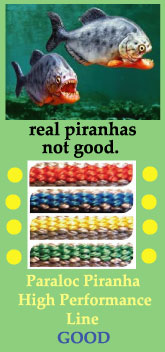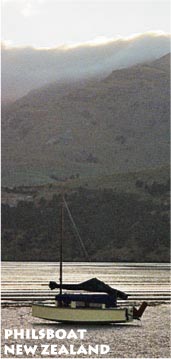
 Custom Search
|
| boat plans |
| canoe/kayak |
| electrical |
| epoxy/supplies |
| fasteners |
| gear |
| gift certificates |
| hardware |
| hatches/deckplates |
| media |
| paint/varnish |
| rope/line |
| rowing/sculling |
| sailmaking |
| sails |
| tools |
| join |
| home |
| indexes |
| classifieds |
| calendar |
| archives |
| about |
| links |
| Join Duckworks Get free newsletter CLICK HERE |
|
|
| Strumpet - Part Two |
by Dan Rogers - Diamond Lake, Washington - USA |
Part One - Part Two - Part Three - Part Four - Part Five The night shift supervisor caught me malingering, in front of the TV set about 2300. He pointed out, that instead of “just sitting there,” I should be back at work. He went on to remind me that if I’d just get a steering wheel and instrument panel mount figured out; the majority of “structural stuff” would be done. Soooooo, now, we have a more or less gingerbread-ready Frankenböt. The “final” piece was to figure out how to set a panel at 15 degrees slope, and against a more-or-less fair camber of a 1-inch drop in 60-inch span. Oh yeah, with about a 12 degree slope to the outboard panel, but with a diagonal component. And, I had to make allowances for re-mounting the shift/throttle control arm business back inside a now-glued and screwed sheer panel (we’ll see in a while, if I guessed that one out correctly.
The kitchen chair has been my goby for several of these ergonomically-questionable projects. I use it to figure how high, how far back, and such. It doubles as an auxiliary Moaning Chair. The aft seat is more or less in place and figured out. In this shot, it’s holding up the little shop vac. And, like EVERY ONE of these jobs I’ve done in the past 5 years; the steering wheel refuses to part from the spindle without becoming chunks, and shards. And, it HAS TO COME OFF, to get re-installed in my fancy new panel. The engine hatch panels in the foreground will hinge fore and aft to the center section. That section will latch down from the inside. The two outboard panels will gull-wing to an open position with some sort of hatch holders, or lay flat individually across the center. The idea is to be able to get at the engine, or even walk all the way aft to the transom without having to perch on the deck-level hatches. It’s sort of a deal I make with the orthopod, to attempt to grow old WITH these boats, instead of growing old BECAUSE of them. And, speaking of orthopoddery; the next phase will require a ton of hand work with re-sawing and shaping and smoothing and fitting a bazillion saw-dulling strips. So far, this is a PL Premium and deck screw job. I’m hoping that the same goop with minimal pin nail fasteners will hook the gingerbread on, and keep it on. And, to compound my violations of All that is Holy within the Real-Boat-Builder Community; a final travesty. The interior taping and sealing will be done with a latex roof seal coat and polyester seam tape that has worked on the past couple of these Frankenböt creations. Remarkably durable, apparently water tight. And, no mixing. No apparent lung irritation, that I get from the ‘pox. Beyond that, a few unknowns persist. This just might be the boat that gets a finished-bright wooden inlay-strip sole covering. Maybe. I just sort of shudder at what beach sand and tenny’s can do to something like that. And, there is still this image of a laminated barrel chair for the Head Posterior, that the Design Department insists on shopping around with the actual builders. Maybe those guys will get their way, yet. Time to start decorating this Frankenböt. Next DayI think this particular excursion into imagination-meets-reality has taught me a valuable lesson. Again. The picture I have in my head, and the product that my stiffening fingers, painful knees, and questionable lower back produce seem to differ, quite a bit. For instance, this grand plan of adding a hardwood deck to an essentially cast-off boat. I could just see the gleaming 7-coats of Schooner Varnish laid lovingly over perfectly milled and finished planks. Those planks had character and figure, with nary a ding, dent, chip, or weather check to be seen. Every plank was exactly parallel side to side, top to bottom. The scarf joints were exquisite. And so forth. I do have to admit the mental picture is what got all this tomfoolery started. And, it’s what sustains it.
(Grist for the mill. Part of my precious tigerwood stack, quietly warping, twisting, and cracking while stored on a cold—and occasional wet—cement garage floor.) You probably know somebody like this. Anyhow. That lesson. Even with the metaphorical shit sandwich; the bread on both sides can still be some pretty good stuff. And, just about any boat that has survived for the past 30 to beyond 50 years, since an assembly line birth was likely made as a shit sandwich. There’s always a lot of unprotected plywood and questionable solid wood stuffed under vinyl and water-absorbing thin foam padding. The vinyl looked absolutely fabulous for several decades, while the plywood slowly returned to mulch and fiber. I say, “fabulous,” in that you might need to remember that once upon a time, people thought Avocado Green was one of the primary colors, Burnt Orange the obvious complement. And carpets came in all the varieties imaginable: shag, and DEEP shag. And, yet. These boats have shown up for work on time most every time, for decades.
(A couple of the almost-finished engine hatches set in place as a reminder of what it all could look like. Maybe, sometime soon.) Really smart guys. The ones at the top of our extended tribe of dreamers and doers, like Welsford, and Michalak, and Leinweber, will all admit it—if you corner them. Boats are ALL compromises. Yep. Every one of ‘em is a compromise. So, I think I’m sort of in good company. Well, I say, “sort of,” not to question the company so much, as whether I’m in it. And, while I’m drawing on outside authority, let me mention my life-long good friend, Mike. Mike doesn’t even like boats. I don’t think he even bothers to read the stuff I laboriously chip out on the keyboard with those stiff fingers and sore wrists. But, Mike does some really nice stuff with wood. He probably spends more time picking out the shades of thousand-grit crocus cloth to fine tune the pool cue he just turned from a piece of exotic magpie tongue tree limb found submerged for the past century; than I would spend building a complete Frankenböt. And, yet. And, yet, I can still see the obvious marks left by his hand work. So, can most anybody. The only way to get “perfect” stuff is to go to Wal-Mart and buy some of that cheap Chinese stuff made by the millions on a million dollar CNC machine. And, who would want to do that, when they could have a piece lovingly carved, turned, or whittled by my friend, Mike? Anyhow. That’s where this project has gone. To the side of compromise. A compromise between what I can pick up, and hold while vibrating in my tired hands, and continue to shove through a whining saw blade. That sort of compromise. Furthermore. I have THREE band saws out in my shop. Each one has a different blade width strung up and ready to cut differing radii. And, ya know what? Not one of ‘em can seem to follow a curved line to make both ends of a cambered deck beam end up the same as it started on the far end. Not one of ‘em can do that, no matter how nice—or not nice—I talk to ‘em. I’ll call it the reality of hand work. But, the real compromise comes when I finally discovered a really silly, really preventable mistake I made. Probably nobody has done this before.
(Bigger boards, becoming smaller boards. Here, after ripping, resawing, bull nosing, and sorting into long, not-so-long, and too-short.) Well, maybe if you’re old enough to remember one of those Nuclear Armageddon flics people used to watch while trying out the composting toilet in their backyard bomb shelters; you’ll remember that movie, “Dr. Strangelove.” Remember, how after an hour of total whacko-hubris, Peter Sellers finally realizes that he’s responsible for blowing the world up? Finally. That’s sort of how I felt when I FINALLY figured our how all my planks seem to have an infinitesimally different twist to ‘em when I get a hatch glued up and ersatz-planked with a hundred pounds of expensive, saw dulling, really heavy and kinda’ brittle stuff. It just never dawned on me that my table saw had wandered out of true. About a quarter of a degree. Maybe a teensey wheensey bit more. But, almost not perceptible when I put a small square to it. But, there you have it.
(One of the 24” x 42” engine hatches. Warts and all. Just out of the clamps, and not yet “leveled.”) Dr. Strangelove sort of blew my world up. Sort of. I remember reading someplace that the human eye can detect differences down to about 1/64 of an inch. And, the finger tips can do even better. Well, my screw up is waaaaay more than a 64th.
(A rough simulation, of a maybe-layout where actual people might someday ride aboard the latest Frankenböt, “Strumpet.”) And, know what? It’s amazing what 120-grit on the business end of a DeWalt orbital can do in a shaking hand. Moving on. |
To comment on Duckworks articles, please visit one of the following:
|
 |









